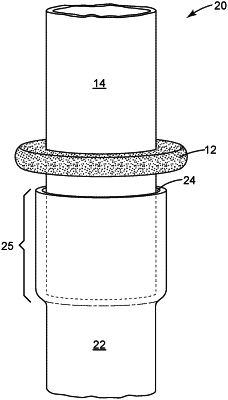| CPC F16L 13/103 (2013.01) [C09J 5/06 (2013.01); F16L 13/11 (2013.01)] | 16 Claims |

|
1. A method of joining two tubular elements, comprising:
providing a first tubular element having a male end portion and a second tubular element having a female end portion, wherein the male end portion and female end portion are both sized such that the male end portion may be inserted in the female end portion;
applying a ring of uncured adhesive on the male end portion of the first tubular element, wherein the uncured adhesive is non-flowable at ambient temperatures, wherein the uncured adhesive comprises an epoxy, wherein the epoxy comprises at least one polyepoxide resin, at least one curing agent, and a toughener;
inserting the male end portion of a first tubular element into the female end portion of a second tubular element, wherein the ring of uncured adhesive is positioned external of and adjacent the female end portion to form a tubular assembly;
heating the ring of uncured adhesive and the male end portion of the first tubular element and the female end portion of the second tubular element to a first temperature sufficient for the ring of uncured adhesive to become flowable adhesive and for the flowable adhesive to spread into radial clearances between the male end portion of the first tubular element and the female end portion of the second tubular element;
orienting the tubular assembly such that the first tubular element is vertical relative to the second tubular element, so as to allow gravity to pull the flowable adhesive from the position external of and adjacent the female end portion into the radial clearances between the male end portion and female end portion; and
curing the flowable adhesive in the radial clearances between the adjacent male end surface of the first tubular element and the adjacent female end surface of the second tubular element by maintaining the male end portion of the first tubular element and the female end portion of the second tubular element, at a curing temperature for a length of time sufficient to cure the flowable adhesive.
|